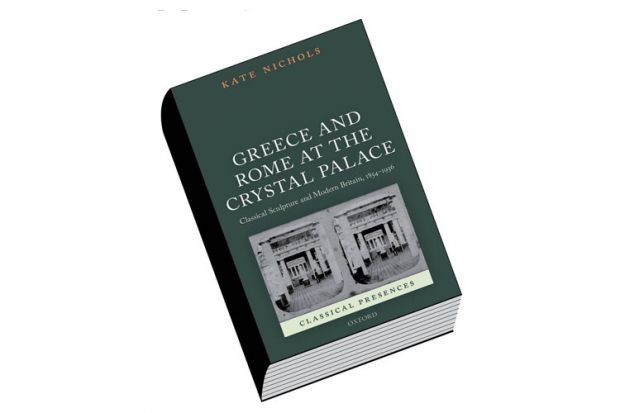Oxford University Press’ Classical Presences series examines how the classical past of ancient Greece and Rome has been revealed, received and interpreted. This much-revised version of a doctoral thesis by Kate Nichols, who is now a postdoctoral fellow at the University of Cambridge, investigates how classical sculpture was displayed and viewed in the re-erected and enlarged Crystal Palace at Sydenham, which opened in 1854.
It is curious that, compared with the vast literature spawned by the Great Exhibition of 1851, the Sydenham Palace has only now begun to be seriously studied by cultural historians. Admittedly, some parts of the permanent exhibitions there, including the “Courts” that gave flavours of Egyptian, Greek and Roman architecture and sculpture, have attracted scholarly attention, partly because the designers responsible included Joseph Bonomi, Owen Jones and Sir Matthew Digby Wyatt, and partly because of the superb photographs taken by Philip Henry Delamotte and published in 1855. Only the Greek and Roman Courts are examined in some detail in Nichols’ interesting monograph, but more could have been made of surviving visual matter. Although Egypt has had an airing here and there, most of the other Courts await forensic examination.
As Nichols notes, classical sculpture was collected on the Grand Tour during the 18th century for display in country houses, and therefore was seen by relatively few people. Of course, work influenced by Greek and Roman exemplars informed neoclassical funerary monuments and memorials that would have been seen by rather more, a point she misses. Institutions such as the British Museum might be thought of as the “natural habitats” for classical sculpture for public display, but as Nichols points out, by the late 1850s the Sydenham Crystal Palace had had some 2 million visitors a year, more than twice as many as those recorded at the British Museum.
Visitors to Sydenham had opportunities to inspect the Courts containing plaster casts of works from major European collections in scaled-down architectural settings such as the Greek Court agora and the “complete”, “perfect” Pompeian House. At the British Museum, the originals, often fragmented, suggested pure whiteness, but at Sydenham, Jones presented coloured and restored sculpture, such as that of friezes. This would elicit furious objections, which Nichols chronicles, even though evidence of Greek polychromy had already been presented by scholars such as Jakob Ignaz Hittorff. At the same time, the educational, improving and accessible aspects of the exhibits at Sydenham were lauded, not least because troublesome travel would have been necessary to view the originals, something far beyond the pockets of the hordes of middle- and working-class visitors to the Palace. Nichols admirably covers these points.
Nevertheless, there were those who raised anguished objections to displays of sculptures of the unclothed male human body, demanding fig leaves or (ouch!) mutilation, and there were even objections to any representations of persons of either gender on biblical grounds (reading these effusions sent a shudder through this reviewer’s fragile frame). The physician John Edward Tilt, in his On the Elements of Health and Principles of Female Hygiene (1852), warned that visits to art galleries by young women put them at risk of excessive “sensory stimulation” that could lead to nervous breakdown and menstrual disorder. Others wondered if the tastes of the masses could ever be improved by displays at all, and one boggles at the huge amounts of onanistic ink spilled over such matters, given due airing in this significant study.
Nichols has been through massive amounts of material (although Quatremère de Quincy is spelled thus, not “Quincey”): particularly commendable is her use of ephemera, diaries, scrapbooks, notebooks and contemporary pamphlets. However, the images accompanying her text, not least the almost illegible “Ground Plan of the Crystal Palace”, are disappointing, and this overpriced volume deserved better than its horribly skimped, almost useless index.
James Stevens Curl is a member of The Royal Irish Academy. The third edition of his book The Oxford Dictionary of Architecture, with contributions on landscape from Susan Wilson, has just been published.
Greece and Rome at the Crystal Palace: Classical Sculpture and Modern Britain, 1854-1936
By Kate Nichols
Oxford University Press, 328pp, £70.00
ISBN 9780199596461
Published 26 March 2015
Register to continue
Why register?
- Registration is free and only takes a moment
- Once registered, you can read 3 articles a month
- Sign up for our newsletter
Subscribe
Or subscribe for unlimited access to:
- Unlimited access to news, views, insights & reviews
- Digital editions
- Digital access to THE’s university and college rankings analysis
Already registered or a current subscriber? Login
